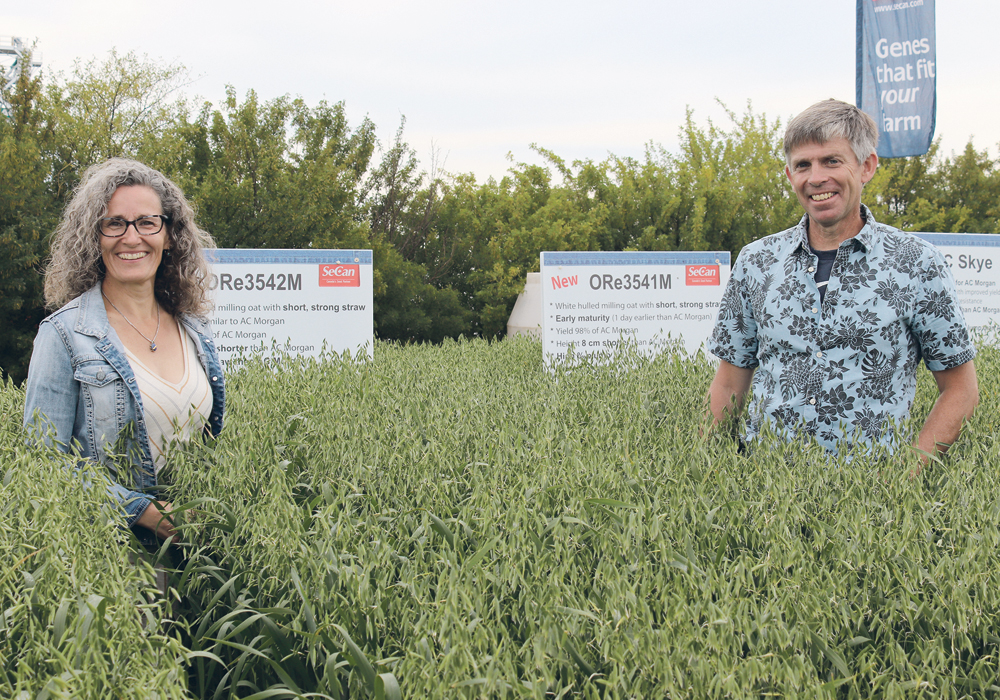A Sask. company has been breeding and developing new oat varieties for the western Canadian market since 2008
Plant breeding is a complex, time-consuming and costly endeavour that typically requires millions and millions of dollars’ worth of human and capital resources.
Companies like Bayer, BASF and Corteva come to mind, as do large publicly funded plant breeding programs like Agriculture Canada and the University of Saskatchewan’s Crop Development Centre.
But not all breeding programs are alike.
Just ask Jim Dyck and his wife, Laura-Lee, owners of a family run oat breeding company called Oat Advantage.
Oat Advantage, based at Saskatoon, has been breeding and developing new oat varieties for the western Canadian market since 2008.
Read Also

Crop quality looks good this year across Prairies
Crop quality looks real good this year, with the exception of durum.
In 2019, the company celebrated the commercial release of its first registered oat varieties, ORe3541M and ORe3542M.
The two milling varieties were planted by commercial oat growers on about 100,000 acres last year across the West.
The varieties were recently approved for milling by Richardson, Paterson Grain and General Mills, three of the country’s biggest buyers. Possible approvals from other processors are also in the works.
With milling approvals in place, Dyck is confident that ORe plantings in 2020 and beyond will continue to increase.
“It’s been a big year for us,” said Dyck, who was responsible for launching an oat breeding program at United Grain Growers in the late 1980s and early 1990s.
“This year (2019) was our first commercial release. By my estimates, we had about 100,000 acres of our two varieties grown in Western Canada, so that was really super.”
“Being a small, family owned breeding company, we are a bit unique,” he added.
“But (becoming a private sector oat breeder) seemed to be almost like a logical path for me because I already had some experience in plant breeding, I knew quite a few people in the industry and I guess I just felt that there was some room in the western Canadian context to do more with the crop.”
Dyck grew up near Winnipeg. He wasn’t a farm kid, but as a youngster, he spent a lot of time on his uncle’s farm and was always interested in agriculture.
In the early 1980s, he landed a summer job with Elanco and a few years later, he enrolled in the agriculture degree program at University of Manitoba.
During his undergraduate studies, Dyck was inspired by well-known teacher and plant science researcher Anna Storgaard, whose lectures sparked an interest in plant breeding.
After completing an undergraduate degree in plant science specializing in plant breeding and genetics, Dyck was offered a job at UGG’s plant research facility near Morden, Man.
He was eventually charged with establishing the company’s small oat breeding program.
In 1994, he moved to Saskatoon where he continued to work with UGG while simultaneously working on a master’s degree at the U of S.
Dyck’s academic adviser at the university was CDC wheat breeder Pierre Hucl.
When UGG merged with Agricore in 2001, Dyck remained with the company and continued his involvement in oat breeding, along with other duties.
Later, when Agricore United was taken over by Saskatchewan Wheat Pool, Dyck wondered about working as an independent plant breeder.
“I think at the time, I just wanted to try something different,” Dyck said.
“Laura-Lee and I already had a small piece of land (near Saskatoon) and at the time I thought there was a bit of a vacuum developing in oat research,” he said.
“It just seemed like a good option at the time because I really liked doing the work (and) I already had lots of friends and contacts in the oat business….”
Now in its 12th year of operation, Oat Advantage is beginning to generate royalty revenues from its first registered varieties.
Both varieties are distributed through the SeCan network.

Dyck describes ORe3541M and ORe3542M as oat varieties with average maturity, slightly above average yield and much better than average lodging resistance.
Early feedback from commercial growers suggests that the varieties produce a high percentage of plump seeds and have a lower than normal cleanout, which is a bonus for seed growers, commercial oat producers and millers.
Dyck said the process of making crosses, selecting promising lines, getting them registered and bringing them to the commercial marketplace takes time.
Even after a new oat variety is registered, there is no guarantee that it will prove to be a good fit for commercial growers or millers.
“It’s exciting to see your varieties being grown by commercial grain farmers but it’s also a challenging time,” he said.
“I feel like we’ve been doing good work and it seems like our varieties offer something that adds value to the oat industry. But right now, we’re really waiting on feedback….”
With more than a decade invested, Dyck said that oat breeding can be an expensive and time-consuming venture with no financial guarantees.
From that perspective, a new royalty collection system that generates additional revenues for the plant breeder would be welcome, he said.
“When we set out in 2008 doing this kind of thing, we didn’t really give much thought to the possibility of collecting additional royalties (off farm-saved seed),” Dyck said.
“But if they (new royalties) are introduced, it would certainly make a big difference.
“(They) would certainly allow us to do a lot more research. They truly would open up the door for us to do a lot more.”
















